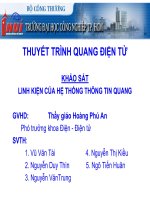H protein synthesis (thuyết trình)
Bạn đang xem bản rút gọn của tài liệu. Xem và tải ngay bản đầy đủ của tài liệu tại đây (3.22 MB, 50 trang )
H protein synthesis
• H1 The genetic code
• H2
Protein synthesis(translation) in prok
aryotes
• H3 Translation in eukaryotes
• H4 Protein targeting
• H5 Protein glycosylation
H1 The genetic code
•
•
•
•
•
The genetic code is a triplet code
The genetic code is degenerate
Universality of the genetic code
Reading frames
Open reading frames
Triplet code
• The nucleotide sequence of the
mRNA is colinear with the amino acid
sequence of the polypeptide in
encodes. The relationship between
them is called the genetic code
• 5’---3’
N terminal-----C terminal
•
•
•
•
The three nucleotides in group called codons
43=64 codons
Initiation codon (AUG)
stop codon ( UAA, UAG,UGA)
Triplet code
The genetic code is degenerate
• 64 codons ,but only 20 amino
acids,so that ,a single amino acid is
coded for by several different
codons, that is degenerate.
• Synonyms:different codons specify
the same amino acid
• Codon and anticodon: a triplet of bases in a
specific tRNA molecule.each base is the codon
base –pairs with its complementary base in the
anticodon.
• Wobble base-pairing
Degeneracy of the genetic code
Wobble rules
Universality of the genetic code
• All living organism used the
same code.
• But there are a few
differences:in mitochondrial
mRNAs, some codons have
different meanings
Different code
Reading frames
Open reading frames
• An open reading frame(ORE) is a
run of codons that starts with ATG
and ends with atermination codon,
TGA TAA or TAG.Coding regions of
genes contain relatively long OPFs
unlike noncoding DNA where ORFs
are comparatively short.
H2 translation in prokaryotes
•
•
•
•
•
Overview
Synthesis of aminoacyl-tRNA
Initiation of protein synthesis
Elongaion
Termination
Overview
• Translation relies upon
aminoacyl-tRNA that carry specific
amino acids and recognize the
corresponding codons in mRNA
by anticodon-codon base-pairing.
Synthesis of aminoacyltRNA(amino acid activation)
Each tRNA molecule has a cloverleaf
secondary structure consisting of
three stem loops, one of which bears
the anticodon at its end. The reaction
is called amino acid activation.
Synthesis of aminoacyl-tRNA is
crucially important for two reasons:
• First :each amino acid must be
covalently linked to a tRNA molecule in
order to take part in protein
synthesis,which depend upon the
adaptor function of tRNA.
• Second :the covalent bond is a
high energy bond that enables the
amino acid to react with the end of
the growing polypeptide chain.
The synthesis reaction occurs in
two steps
• The first step is the reaction of amino
acid and ATP to form an aminoacylAMP.
• The second step is the aminoacyl
group of aminoacyl-AMP is
transferred to the 3’end of the Trna
molecule to form aminoacyl-tRNA.
Step one
Step two:
Aminoacyl-AMP+tRNA-----aminoacyl-tRNA +AMP
Initiation of protein synthesis
fMet-tRNAfMet
Elongaion









